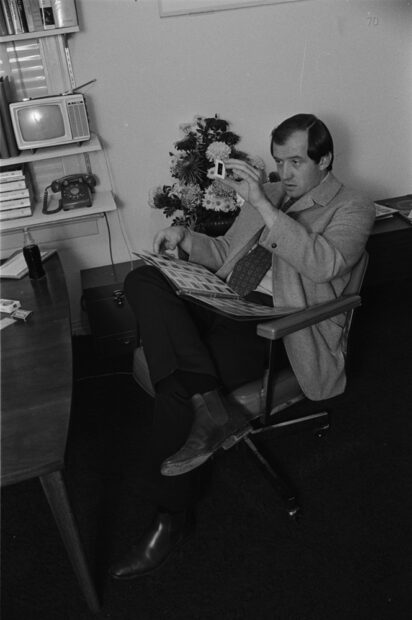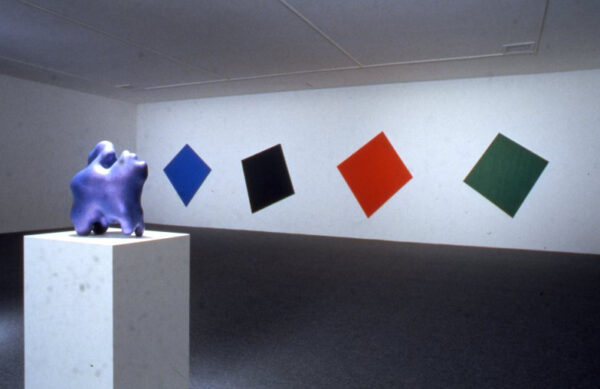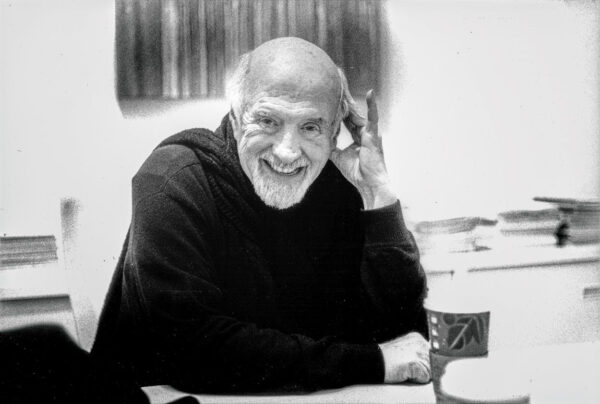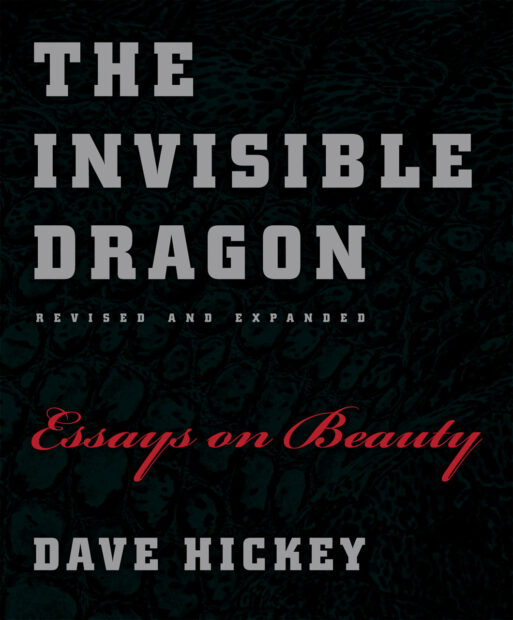Dave Hickey, the widely known writer and cultural critic, died at his home in Santa Fe, New Mexico on November 12th, following a long struggle with heart disease. He was 82.
Dubbed by Newsweek as “The Bad Boy of Art Criticism,” Hickey was a writer through and through. Although he had been working for decades prior, he first became widely recognized for his 1993 book The Invisible Dragon: Four Essays on Beauty, which defended the concept of beauty in contemporary art — a radical cri de coeur at the time. His 1997 publication Air Guitar: Essays on Art & Democracy focused on Hickey’s range of aesthetic interests, from Andy Warhol to Perry Mason to Liberace.
Hickey’s writing appeared in many mainstream and art-centric outlets, including ARTnews, the Village Voice, Rolling Stone, Harper’s, Vanity Fair, and Glasstire, among others. Much of his work, in addition to addressing broader cultural happenings as well as now-well known artists, wove in stories from his personal life and experiences. Oftentimes these narratives included mention of his contemporaries — people like Townes Van Zandt, Lou Reed, Ed Ruscha, Robert Rauschenberg, and Andy Warhol.
Although his writing became well known and admired among artists and arts professionals, Hickey often felt like an art world outsider. In ways, this is understandable, as his writing championed a kind of populism that many thumbed their noses at: he combined essays about the pull of Walt Disney’s parks and about the splendor of Vegas’ Liberace Museum with his thoughts about famous artists and artworks, like Ruscha’s highly praised book Twentysix Gasoline Stations.
Still, Hickey in many ways was intimately familiar with the movers and shakers of the art world and market. In an interview with the Observer, he waxed poetic about the pricing of artists’ works, saying, “I started out as a dealer and most of my writing is market-driven. I have this old-time notion that there should be some equity between price and value. If I think somebody is underpriced, I try to raise their prices. If I think somebody is overpriced, I try to lower their prices.”
Though it wasn’t universally praised, Hickey’s blending of high and low appealed to many, especially to other writers and critics. Referring to a catalog essay by Hickey for a show of works by Ruscha, Christopher Knight, the art critic for the Los Angeles Times, wrote in a tribute to Hickey: “his essay made paintings that I loved intelligible in plainspoken, even obvious ways that the critical baggage of High Art pretensions had hitherto obscured. The vernacular was good enough — for the artist and the art critic.”
Dave Hickey was born in Fort Worth, Texas in 1938. He was the youngest of three siblings. His father was a jazz musician who also worked various other jobs, and his mother was a painter and a teacher. His family moved around the U.S. following Hickey’s father’s various careers — to Oklahoma, Louisiana, and Southern California, where Hickey developed a passion for surfing. According to Daniel Oppenheimer, who recently published a book about Hickey, he had an unhappy childhood, in part because his parents didn’t get along. Because of this, Hickey spent his days out of the house — at movie theaters, libraries, and record stores.
In 1954, the Hickey family returned to Fort Worth so Hickey’s mother could take up a job at her family’s store. The next year, when Hickey was sixteen, his father committed suicide. (Other accounts of Hickey’s life claim that Hickey’s father died when he was eleven. In an essay in The Point, Oppenheimer writes that Hickey, erroneously, frequently said he was only eleven or twelve at the time of his father’s suicide.)
Hickey stayed in Fort Worth for college, attending and graduating from Texas Christian University. He moved to Austin and completed most of a doctoral program in linguistics at the University of Texas at Austin before dropping out. In 1967, he and his then-wife Mary Jane opened the gallery A Clean, Well Lighted Place in Austin, which was named for a story by Ernest Hemingway.

Dave Hickey in his office at his gallery, A Clean, Well Lighted Place, on November 13, 1969. Photo: Austin American-Statesman/USA Today Network
During the gallery’s run (it closed in 1971), it showed works by Jim Franklin, Peter Plagens, Stephen Mueller, Terry Allen, Luis Jiménez, Mel Casas, Jim Roche, and others. Annette Carlozzi, former curator of the Blanton Museum of Art in Austin, said of Hickey’s curation of A Clean, Well Lighted Place: “It was singular in Austin’s history of tastemaking…Dave’s selections were so acutely sensitive to the trends of the moment that were happening on both coasts as well as in Texas. They were sophisticated in a way that nothing else in Austin was, at least off campus, outside of UT’s rich intellectual environment.”
It was during this time that Hickey also organized South Texas Sweet Funk, an exhibition at Austin’s St. Edward’s University that metaphorically blew the lid off of “Texas art.” The show was covered in Artforum and, according to Hickey, “We created this monster called Texas Art…We had begun by trying to convince people that there was something special happening in the visual arts down here, and reaching for the metaphor at hand, we invoked the mythos of Texas.”
In the 70s and 80s, Hickey held numerous jobs in just as many cities: he moved to New York City in 1971 and began working for Reese Paley Gallery in Soho. In 1972, he helped organized the Dripping Springs Reunion concert, a gathering of musicians on a ranch near Dripping Springs, Texas. The concert featured performances by Waylon Jennings, Terry Allen, Loretta Lynn, and many others.
Later in the 70s, Hickey upped his writing and served as an executive editor at Art in America. Still later, he lived in Nashville, working as an occasional songwriter and music promoter. In 1978, Hickey moved back to Fort Wroth, bringing with him, according to Oppenheimer, “a bad case of pneumonia and a months-long hangover.” Hickey had been a drug user throughout his life, and said that his return to the city followed his long use of “uppers and downers.”
Still, during this period Hickey continued to write. He worked for a time as the Fort Worth Star-Telegram’s art critic; he authored numerous exhibition catalog essays; and he continued to write pop songs. Following Hickey’s mother’s death, he moved in with his then-partner, Fort Worth Art Museum curator Susan Freudenheim.
Hickey and Freudenheim moved to San Diego in 1987, and then broke up. Shortly thereafter, Christopher Knight connected Hickey to Gary Kornblau, the founder and editor of Art Issues Magazine, who was looking to publish writing in Southern California. According to Knight and to Oppenheimer, Hickey’s relationship with Kornblau provided just the springboard and platform he needed to begin (or, continue) writing with intent. Hickey published essays in the magazine, and eventually Kornblau’s press, Art issues Press, published both The Invisible Dragon: Four Essays on Beauty in 1993 and Air Guitar: Essays on Art and Democracy in 1997.
In the late 80s, Hickey served as a visiting professor in Las Vegas, and then in New Mexico. It was here that Hickey met his future wife, Libby Lumpkin, a PhD student who had been assigned as his teaching assistant. The pair moved back to Vegas in 1990 (Hickey reportedly preferred the city to New Mexico), and became immersed in the city’s art community.
Hickey took on a professorship at the University of Nevada, Las Vegas (UNLV), where he eventually earned tenure. During his 20 years at the school, he recruited artists, budding critics, and other writers to attend the program, with him as its main attraction. According to Las Vegas Weekly’s 2009 profile of Hickey and Lumpkin, Hickey fully embraced the city’s culture and aesthetics in his teachings. His courses were not particularly theory-heavy, as Hickey avoided normal art world pedagogy; instead, he provided (some sarcastic and some not-so-sarcastic) nuggets of wisdom: “I would tell them they had to go to LA and see the shows. They have to know what is going on in the art world…I could tell them the best thing to wear to their first opening is a $10,000 Armani jacket and a Joy Division T-shirt. I gave them good tips of that sort.”
Lumpkin emphasized to the Las Vegas Review-Journal that teaching was Hickey’s true passion, telling the publication “I think he would primarily want to be remembered as a teacher. He loved his students…Let me tell you, it’s been an outpouring for him. I’m getting calls from students I’ve never even known.” Hickey was inducted into UNLV’s College of Fine Arts Hall of Fame in April of 2021.
As the years wore on and Hickey’s writing became more widely read, recognition of his work grew. In 2001 he was named a MacArthur “Genius” Fellow, a grant that came with a $500,000 award. (Multiple accounts joke that Hickey’s winnings went immediately into the Vegas slot machines he frequented.) After Hickey’s death, Knight wrote that he had quietly nominated Hickey for the award in “an absurdly long but successful recommendation, emphasizing that the grant would reflect magnificently on the foundation, not the recipient, since everyone already knew he was a genius.” Knight also called Hickey “the closest thing to that vanishing breed — a public intellectual — that America’s vain world of visual art could claim.”
Though his Genius Grant was definitely the largest marker of his success, Hickey had other accomplishments in the early and mid-aughts. He was inducted into the Nevada Writers Hall of Fame by the University of Nevada, Reno in 2003, and he received a Peabody Award for a 2006 PBS documentary about Andy Warhol.
He also curated Beau Monde: Toward a Redeemed Cosmopolitanism, the 2001 SITE Santa Fe Biennial exhibition. In his curatorial statement, Hickey explained his concept behind the show, stating that the exhibition would include “artists from as many generations as possible, working in a variety of modern and postmodern styles.” He went on: “In this way, I hope to reflect the actual circumstances of day-to-day contemporary art-making and dramatize the tides of artistic influence and reaction as they manifest themselves temporally as well as geographically.”

Works by Ken Price and Ellsworth Kelly installed in the 2001 exhibition Beau Monde: Toward a Redeemed Cosmopolitanism at SITE Santa Fe. Hickey curated the biennial
In 2010, Hickey and Lumpkin left Las Vegas for teaching positions at the University of New Mexico (UNM) in Albuquerque. Hickey had enjoyed his time in Vegas, but lamented his inability to fight off theory in the college and the art world at large, saying, “this is the first time I left a work situation not better than when I came. I haven’t been able to make a dent in this pedagogical community.”
Hickey’s first book following his move to Santa Fe was his 2013 collection Pirates and Farmers: Essays on Taste, published by Ridinghouse. In conjunction with the book’s release, Glasstire organized a talk by Hickey at Rice University in Houston.
About seven years ago, Hickey retired from his position at UNM. Around the same time, in 2014, when Hickey was in Miami for the annual December art fairs, he experienced a ruptured aortic aneurysm. After this, his ongoing health troubles prevented him from traveling consistently, partly because, as Oppenheimer claims, Hickey “couldn’t fly without risking another aortic rupture.”
In the years since, Hickey was busy writing and publishing. In 2016 the University of Chicago Press published 25 Women: Essays on Their Art, and in 2017 the same press published Perfect Wave: More Essays on Art and Democracy, a sort of follow-up to Air Guitar. In his later years Hickey was also very active on social media platforms — particularly Facebook. Since he was tethered to his home in Santa Fe, he used the platform as a way to reach his fans, fellow critics, former students, artists, and everyone else. His Facebook page quickly amassed a significant following and became a discussion board for everything from theories on writing to pop culture.
Seeing the value in these decentralized discussions, the art historian, writer, and curator Julia Friedman worked with Hickey to amass his social media musings (and his friends’ and followers’ responses) into two books, both published in 2016: Wasted Words: The Essential Dave Hickey Online Compilation and Dust Bunnies: Dave Hickey’s Online Aphorisms.
Hickey was a sharp wit and had a trademark, gruff manor of speaking. He always had a cigarette and a coffee in hand, and he was never afraid of a little banter. He will be remembered by those who knew him and his work as one of the most influential art and cultural critics of the 20th and 21st centuries.
There is an inescapable Texan ethos burned into Hickey’s writing; he was a solo rider, and didn’t care if anyone joined him on the road. Hickey saw this as both a blessing and a curse. In 2015, for a Texas Monthly article titled Don’t Move to Texas, he wrote that “Everything in Texas is exceptional by virtue of being in Texas. To demean a single Texas fence post demeans them all—and this is treachery… Nothing is wider than Texas, or narrower. So there is no work for critics like myself who volunteer high-spirited opinions for your amusement and education.” He went on: “I only enter Texas with a return ticket, a passport, and pesos, lest Texas secede while I’m there and the Dallas Cowboys become a soccer team. Should this happen, I will stage a rock concert just across the Oklahoma line. James McMurtry will kick things off with ‘Choctaw Bingo,’ and we will fill the sky with fireworks and play funky music as the tanks roll by, leaving Texas and entering the plain old, unexceptional United States.”
Overall, Hickey was a champion for what he believed in, and he truly believed in art. In a 2016 interview, when asked how he looks at art, Hickey had this to say: “I’m really never looking at a piece of art. Usually I’m walking through a gallery or a museum and I walk until something stops me. And if it stops me I look at it…I like that kind of BANG. I look at it and I relate it to what I have seen.”
Hickey is survived by his wife, Libby Lumpkin, and his younger brother, Michael Hickey. A memorial service for Hickey is scheduled for November 30th at 1 PM at the Rosario Cemetery in Santa Fe. In lieu of flowers, Lumpkin requests that donations be made to the University of New Mexico in support of its art history program.





2 comments
Zach’s obituary of Hickey is heart felt and well-deserved. Maybe Hickey, however, did not teach at the University of New Mexico in Santa Fe, but in Albuquerque. While “Texas exceptionalism” has been effectively roasted in the realms of politics, social services, healthcare and other arenas of daily life, it might be time to give the notion some critical review in the realm of the arts.
I believe Brandon’s last name is Zech, not Zach.